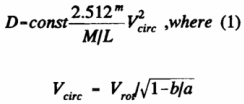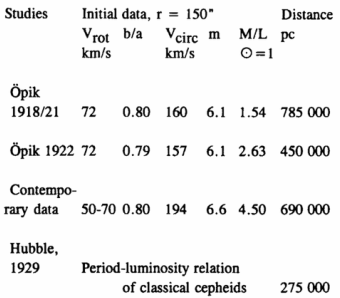
|
Öpik ja spiraaludude olemus |
{ M. Jõeveer Geodeet 6(30) 1994 14-15 }
Öpik and the Nature of Spiral Nebulae
M. Jõeveer
Tartu Astrophysical Observatory, Tõravere, Tartumaa, EE2444, Estonia
On hinnatud Ernst Öpiku poolt 1921.a. ja 1922.a. leitud Suure Andromeeda udukogu kaugusmäärangute usaldusväärsust. Nii lähteandmete täpsuse, kui ka kasutatud uudse dünaamilise meetodi poolest tuleb Öpiku tõid pidada eeskujulikeks, neis saadud kaugushinnangud (785 000 parsekit (pc) ja 450 000 pc) on heas kooskõlas tänapäeval aktsepteeritud M31 kaugusega (690 000 pc). Kaasaegsed ei pidanud Öpiku töid usaldusväärseteks ja omistasid galaktikate kauguste määramise esmaau hiljem ja ebatäpseid tulemusi saanud ameerika astronoomile Edwin Hubble'le. Mitteusaldamise põhjusteks võib lugeda:
1.Öpik oli sellal noor ja tundmatu,
2. ta ei kuulunud ühtegi tunnustatud koolkonda,
3. ta töötas pioneerliku, aga kaasaegsetele harjumatu meetodiga,
4. ta ei kasutanud suuri teleskoope, rääkimata maailma suurimatest teleskoopidest, mis olid Hubble käsutuses.
Öpiku tööde väärtuse tunnetamiseni jõudsid alles järgmiste põlvkondade astronoomid. Öpiku tunnustamisel mitmesuguste ülikoolide ja teadusühingute autasudega märgiti alati, muude arvukate saavutuste hulgas, ka tema tööde pioneerlikkust galaktikate kauguste määramisel.
In the first decades of this century one of the most exciting topics in astronomy was the nature of the spiral nebulae. The question was: are they nearby real nebulae inside the Milky Way stellar system, or distant stellar systems (island universes) outside the Milky Way? To get the right answer, the largest telescopes of the world, mostly at the western coastal area of the U.S.A., were used. The prevalent method was direct photographing with the aim of registering the brightest stars in the nebulae. The next steps were to classify these stars, to search similar stars in the Milky Way and to compare their apparent magnitudes in order to estimate the distance differences. Observers on the Mt. Wilson 1.5- meter telescope were very near to the solution in years 1917-1918 after discovering several novae in the M31 and in the other spiral nebulae. Apparent magnitudes at maximum of novae in the largest spiral nebulae suggested that the distances to parent nebulae are 100 times larger compared with the distances of Milky Way novae (Curtis 1917), i.e. about one million light years. However, the result was quite uncertain, because one of best known novae (S And, later classified as supernova) indicated much smaller distances. In 1920 on the special discussion, on the so-called Great Debate, at the National Academy of Sciences of U.S.A. the problem remained open. The arguments for and against the spiral nebulae being independent stellar systems outside the Milky Way, were balanced.
However the solution was very near, actually it was already reported, but not published, of course, not in the U.S.A. In 1921 Öpik published in a modest Petrograd journal "Mirovedeniye" the paper "Probable distance to the Great Andromeda nebula, in connection with the nature of the spiral nebulae". A footnote tells that already at the end of 1918 the results of this study were reported to Moscow Society of Amateur Astronomers. Long delay with the publication can be explained by the chaos into which Russia plunged under the Bolshevist rule. Starting from summer 1918 connections with the western countries were severed, it became impossible to publish scientific papers, the main goal was to remain alive.
Öpik's work was induced by a paper by Pease (1918) about the rotation curve of M31 (fortunately, the corresponding volume was among the last scientific journals which reached Russia before the gap between the second half of 1918 and the end of 1920 occurred). Obviously, after reading that paper, Öpik either immediately or very soon realized the importance of rotational data in estimating the distances. He elaborated a simple dynamical method for estimating the distances to spiral nebulae on the basis of their rotation velocities Vrot at the radius r from the centre of nebula and apparent magnitudes m inside the radius r. Underlying the method was an assumption that the same mass-to-luminosity ratio M/L can be adopted for our Galaxy and the spiral nebulae. In modern designations Öpik's formula for finding the distances D to the nebula with apparent flatness b/a can be written as follows:

From the data available to him in 1918, Öpik found the estimate 785 000 pc for the distance of Andromeda Nebula M31. The investigation yielded one magnitude as an estimate to the upper limit of the absorption of light beam of M31. On the basis of both his own investigation and independent studies by others Öpik (1921) concluded that "... most probably spiral nebulae are stellar systems similar and equivalent to our Milky Way system".
After returning to Estonia in December 1921, Öpik had a possibility to learn the astronomical literature of the latest years. Being convinced, that no serious progress was made in the recent years in solving the nebulaes enigma, Öpik wrote a new version of his investigation using fresher data. Among other results he was able to measure the flatness of the central part of M31 using the photos made by the Petzval astrograph of the Tartu observatory.

In the table the original data for M31 used by Öpik are compared with modern data. Distances in the last column of the table are as they were computed by Öpik by formula (1), the adopted modern distance estimate is a mean value of distances obtained by various methods.
As one can see, the initial data used by Öpik are in satisfactory accordance with modern data. Even better is the accordance between the distance estimations, because of some smoothing of data in formula (1).
Öpik's works were the first attempts to measure the distance of spiral nebula with reliable method with good accuracy. Next was the Mt. Wilson astronomer Edwin Hubble in years 1925-1929, whose results were not so accurate. But in these years it was not known that the distance of M31 is of the order of 700 000 parsecs and the impression from the Hubble works with observational data obtained on the largest telescope of the world was blinding. So the honour of pioneering in measuring the distances to the spiral nebulae was granted to Hubble. Evidently it was hard to accept the solution of this very fundamental problem by:
1. an almost unknown young astronomer,
2. from an unknown school,
3. using an unconventional method,
4. without any large telescope, not speaking about the largest telescope of the world.
Öpik never turned to the topic of extragalactic distance scale again. After some decades he became famous with his works in many other fields of astronomy, his ability to find effective unconventional solutions became well-known. And of course, astronomers of next generations learned that the distance of M31 is much larger in comparison with estimates by Hubble and that they are in better accordance with estimates made by Öpik. Only after that tribute was paid to Öpik too. Öpik merited different prizes and honorary degrees from universities and scientific societies. His pioneering works on the distance to the Andromeda nebula were always noted in the citation remarks at the presentation of the prizes. But the textbooks with Hubble's discoveries were already written, and ... it is very complicated task to rewrite the textbooks, especially the sacred parts of them.
References
1. Curtis, H.D. 1917, Publications of the Astronomical Society of the Pacific, 29, 206-207.
2. Hubble, E. 1929, The Astrophysical Journal, 69, 103-158.
3. Pease, F.G. 1918, Proceedings of the National Academy of Sciences, 4, 21-24.
4. Öpik, E. 1921, Mirovedenie, 10, 12-20.
5. Öpik, E. 1922, The Astrophysical Journal, 55, 406-410.